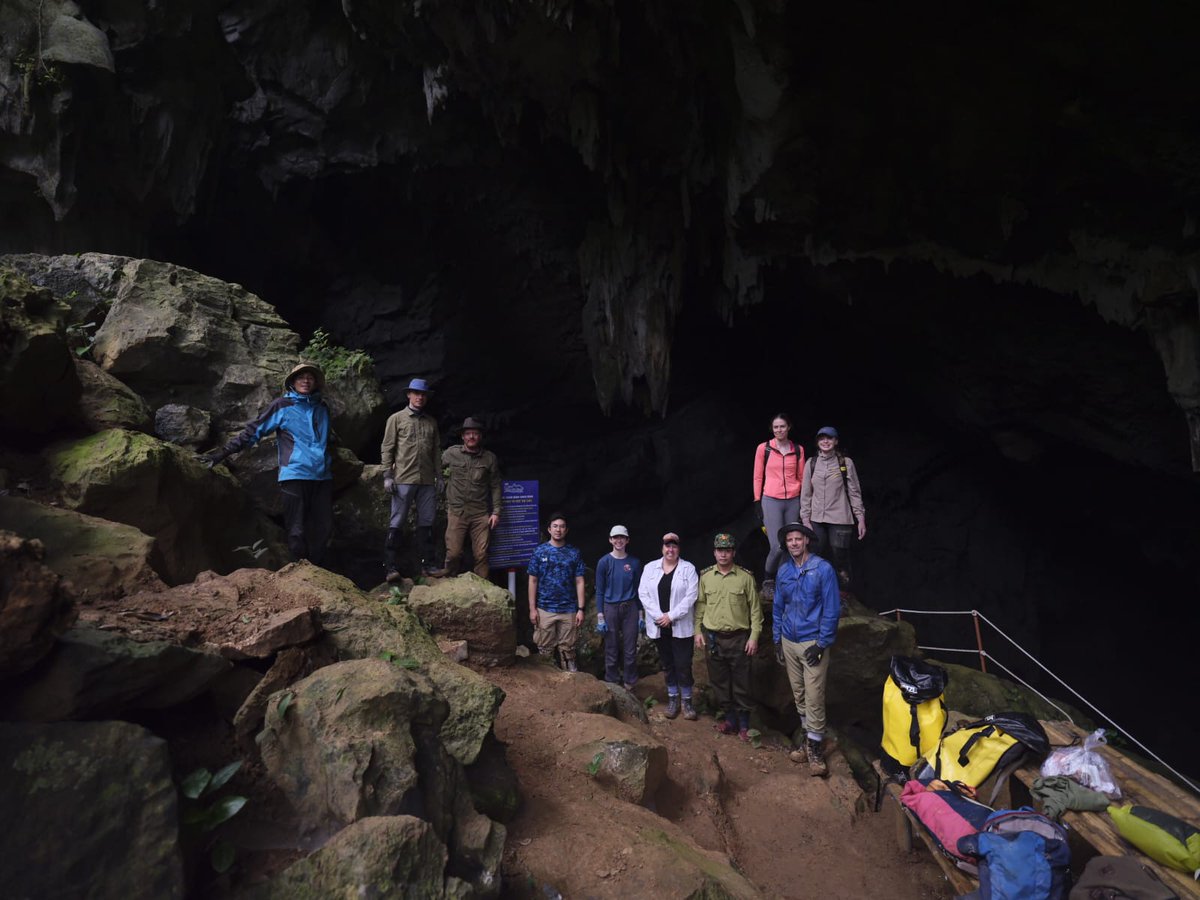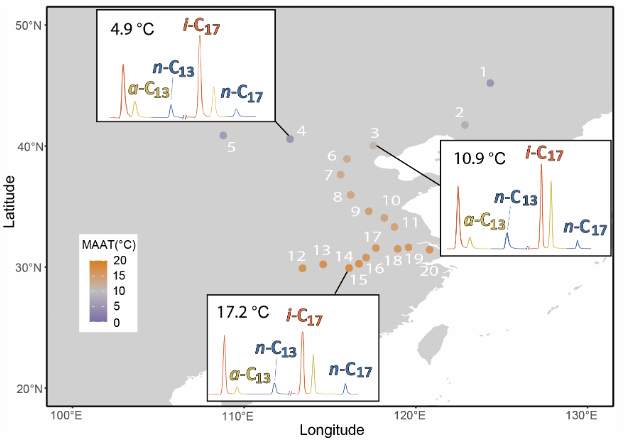December 2023: My Lapworth Museum public lecture “Crete: Building a Palaeoclimatic Framework for Europe’s Oldest Civilisations” is available through the hyperlink (Passcode: 7Y+!ys8z).
Collaboration with artist Mark Kasumovic – capturing fieldwork seasons in Crete, S.E. Asia
I have been collaborating with Dr Mark Kasumovic, an award-winning Canadian artist and academic based in the UK (De Monfort University). His current project investigates the relationships between technology and knowledge production within the context of scientific research. He accompanied our teams in Vietnam and Crete in 2023. In addition to recording materials for his own art project (work ongoing), Mark took a series of conventional fieldwork photos which can be seen via the links above.
1/3 #Paleoclimate fieldwork at the spectacular Hoan My cave in Phong Nha-Ke Bang NP @UNESCO. Partnering with the park authorities and @PaleoclimateVN. Photos credit to Dr Mark Kasumovic #bruminthefield @geology_bham @LES_UniBham @PHRC_DeMontfort #Vietnam #Caves

2/3 with @mickgriff02 @cavesandclimate @geolica @PaleoclimateVN @paleopatt @AnnabelWlf @Clo_Riviera #Vietnam #bruminthefield

3/3 #Vietnam #bruminthefield Photo credits: Mark Kasumovic @AnnabelWlf
Originally tweeted by James Bendle (@DrBendleJ) on March 6, 2023.
1/3 #Biomarker and #DNA #Paleoclimate fieldwork in the Ngoc Linh mountains and Da Nang region #Vietnam. Funding from @LeverhulmeTrust @NERCscience, Thai Min of DPST & @PHRC_DeMontfort . Photo credit to Dr Mark Kasumovic @geology_bham @LES_UniBham #bruminthefield

2/3 @Barbour keeping me dry in Ngoc Linh cloud forest #Vietnam

3/3
Leech check 🪱! We’ve learned the hard way to check our boots after a trek through the Vietnamese rainforest. We don’t want to bring any unwanted visitors with us into the cave.
However, sometimes leeches are useful! Here @DrBendleJ collects a sample from @AnnabelWlf’s shoe.
Originally tweeted by Elizabeth Patterson (@paleopatt) on March 4, 2023.
Originally tweeted by James Bendle (@DrBendleJ) on March 6, 2023.
Jan 23 fieldwork in #Athens and #Crete. Meetings with archaeologists @BSAthens, local ephorates then installing cave monitoring equipment with @geolica, Prof. Yorgos Iliopolous and @geology_bham @LES_UniBham students. #bruminthefield

Originally tweeted by James Bendle (@DrBendleJ) on January 23, 2023.
1/6: Relaunch! Our proxy development paper “Appraisal of paleoclimate indices based on bacterial 3-hydroxy fatty acids in 20 Chinese alkaline lakes” is out in Organic Geochemistry:
https://tinyurl.com/5c35t2ca
by @YiYangcug Dr http://C.Wang @DrBendleJ Prof S. Xie et al.

2/6: We analyze 3-OH-FA lipid distributions in 20 Chinese alkaline lakes samples to study the environmental factors controlling the relative distribution of the 3-OH-FA isomers over a MAAT range of 5 to 17°C.
3/6: The soil temperature proxies RAN15 (previously applied to a stalagmite) and RAN17 do not appear to be suitable for temperature calibration. However, the marine temperature proxy RAN13 was moderately correlated with the MAAT gradient in lake sediments.
4/6: We propose a novel temperature proxy (RIN17, ratio of the iso to normal C17 3-OH-FA) for lake environments.

5/6: This further highlights the potential use of bacterial 3-OH-FAs as proxies for paleoclimate reconstruction in both aquatic and terrestrial environments.
6/6: Relaunching due to an error in the original proofs – now fixed and proofs are back up online with OG.
Originally tweeted by James Bendle (@DrBendleJ) on September 1, 2021.

The University of Birmingham will be hosting (for the first time ever) the British Organic Geochemical Society Conference in 2021 (20th – 22nd July). Please visit our webpage for the latest information.
New Paper: OPTiMAL: A new machine learning approach for GDGT-based palaeothermometry
Published in December 2020 this paper was amongst the top most viewed and downloaded papers during it’s period in open review in Climate of the Past. The work is a GEES and Physics collaboration led by Yvette Eley and Tom Dunkley Jones, with contributions from Sarah Greene, Kirsty Edgar and James Bendle in GEES and Will Thompson and Ilya Mandel (Physics). The work derives from NERC standard grant Reducing Greenhouse Proxy Uncertainty (GEES Investigators Dunkley Jones, Bendle, Edgar).
https://twitter.com/jhgeol/status/1334193731768094722?s=20
New Paper: A new sea surface temperature proxy based on bacterial 3-hydroxy fatty acids
Published in May 2020. This paper was in the top five most downloaded articles during it’s first three months in the journal Organic Geochemistry. The work is the product of close collaboration between myself and previous GEES visiting CSC scholars Yi Yang and Canfa Wang.
PhD Viva Success and First Publications for Kate Ashley
Kate Ashley, passed her PhD viva earlier this year with Prof Erin McClymont (Durham) and Dr Peter Hopcroft (Birmingham) examining. Kate was supervised by James Bendle with inputs from many other GEES academics, especially Sarah Greene and Yvette Eley. Her thesis investigates the use of algal biomarkers from marine sediments for reconstructing Antarctic environmental change in the Holocene. Antarctic coastal zones play a key role in regulating global climate, through sea level change, ocean circulation and the global carbon cycle. Kate’s first papers are in Climate of the Past and Biogeosciences.
Birmingham Organic Geochemists at the 30th British Organic Geochemical Society (BOGS)
Several members of the Birmingham Molecular Climatology Group (James Bendle, Yvette Eley, PhD students Jonathan Hall and Bridget Warren, and MSci student Alice Hardman) presented their research at the 30th British Organic Geochemical Society (BOGS) Annual Meeting at Manchester Metropolitan University in early July (9th to 11th).

James presented a poster on the first application of bacterial and plant-wax isotopes from a stalagmite to reconstruct past temperature, hydrology, vegetation and carbon-cycle changes in central China. Yvette chaired the palaeoclimate and onotolgy session and presented her recent work on a new machine learning approach for palaeothermometry, called OPTiMAL, which improves temperature estimations and is the result of a collaboration with Ilya Mandel and colleagues in GEES and the School of School of Physics and Astronomy and is a key outputfrom a NERC standard grant. Jonathan’s poster summarised his research on Mid-Pliocene sea-surface and terrestrial temperature reconstructions in the North Atlantic, including estimates from biomarkers in brown coals collected during recent fieldwork in Iceland. Alice’s poster addressed the ongoing development of the 3-Hydroxy Fatty Acid (3-OH FA) palaeoclimate proxy for temperature and pH reconstructions, and outlined her MSci research which involved producing the first 3-OH FA-based indices from a continental-scale soil transect along the US East Coast. A GEES Pump-priming award and Leverhulme Trust standard grant helped to fund both Alice and James’s work. Bridget’s poster discussed the application of leaf waxes as a valuable palaeoclimate proxy for recording past atmospheric CO2 concentrations, and showcased her planned investigations in conjunction with the BIFoR Free Air CO2 Enrichment experiment.
Jonathan and Alice both received prizes for best and runner-up posters, respectively. Everyone really enjoyed the conference and valued the opportunity to present and discuss their research with other members of the organic geochemistry community. We are delighted to announce that Earth Sciences and the School of GEES will be hosting the 31st Annual BOGS Meeting in summer 2021.
